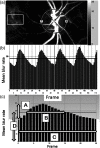Clinical applications of laser speckle contrast imaging: a review
- PMID: 31385481
- PMCID: PMC6983474
- DOI: 10.1117/1.JBO.24.8.080901
Clinical applications of laser speckle contrast imaging: a review
Abstract
When a biological tissue is illuminated with coherent light, an interference pattern will be formed at the detector, the so-called speckle pattern. Laser speckle contrast imaging (LSCI) is a technique based on the dynamic change in this backscattered light as a result of interaction with red blood cells. It can be used to visualize perfusion in various tissues and, even though this technique has been extensively described in the literature, the actual clinical implementation lags behind. We provide an overview of LSCI as a tool to image tissue perfusion. We present a brief introduction to the theory, review clinical studies from various medical fields, and discuss current limitations impeding clinical acceptance.
Keywords: burn wounds; cerebral blood flow; laser speckle contrast imaging; microcirculation; retinal perfusion.
Figures









Comment in
-
Assessing the Microcirculation of the Foot with Laser Speckle Contrast Imaging During Endovascular and Hybrid Revascularisation Procedures in Patients with Chronic Limb Threatening Ischaemia.Eur J Vasc Endovasc Surg. 2022 Jun;63(6):898-899. doi: 10.1016/j.ejvs.2022.03.036. Epub 2022 Apr 8. Eur J Vasc Endovasc Surg. 2022. PMID: 35739040 No abstract available.
References
-
- Fercher A., Briers J., “Flow visualization by means of single-exposure speckle photography,” Opt. Commun. 37(5), 326–330 (1981).OPCOB810.1016/0030-4018(81)90428-4 - DOI
-
- Briers J. D., Webster S., “Quasi real-time digital version of single-exposure speckle photography for full-field monitoring of velocity or flow fields,” Opt. Commun. 116(1–3), 36–42 (1995).OPCOB810.1016/0030-4018(95)00042-7 - DOI
Publication types
MeSH terms
LinkOut - more resources
Full Text Sources
Other Literature Sources
Medical

